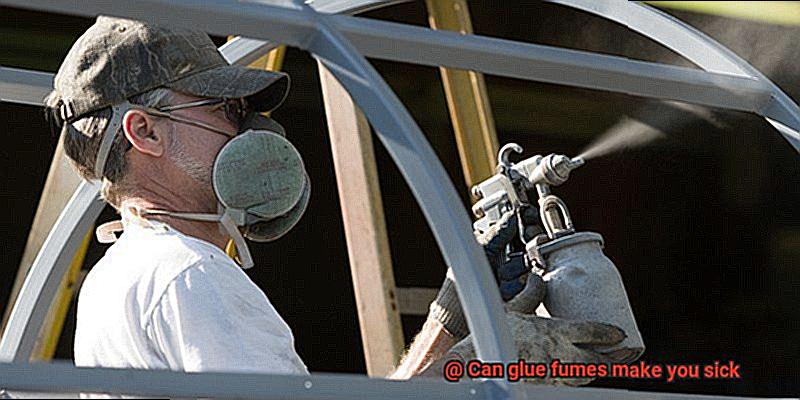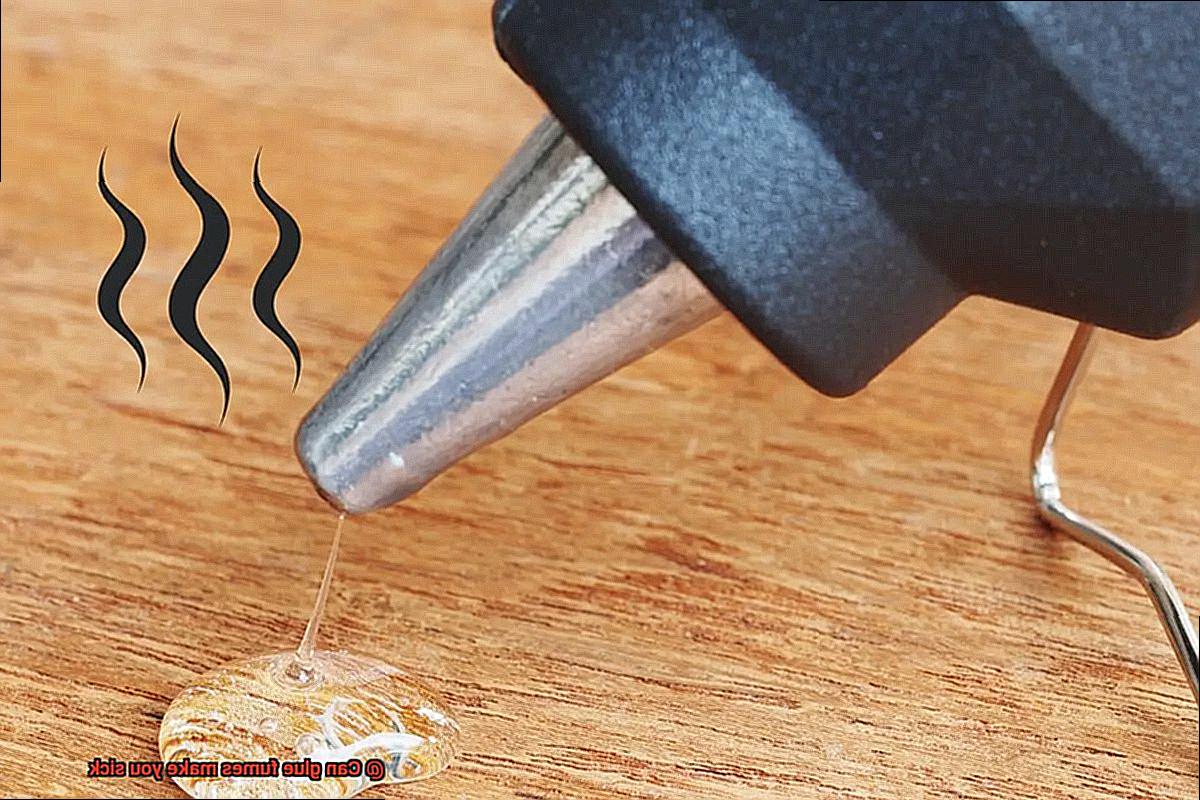We all know that glue is the unsung hero of our creative endeavors, holding everything together with its sticky embrace. But have you ever wondered if those seemingly innocent glue fumes could be secretly plotting against your well-being? Prepare to be surprised, because these fumes can actually pose some serious health risks.
Imagine this: you’re happily crafting away, inhaling those intoxicating adhesive aromas when suddenly, a headache hits you like a wrecking ball. Your head spins like a rollercoaster gone rogue, and before you know it, nausea takes over. These immediate symptoms are just the tip of the iceberg. Prolonged exposure to glue fumes can lead to even more alarming consequences such as impaired brain function or damage to vital organs like your liver and kidneys.
In this blog post, we’re diving headfirst into the hidden dangers of glue fumes. Brace yourself as we explore the potential side effects they can have on your health. From unraveling the science behind these sneaky fumes to examining the possible symptoms and effects they may bring about, we aim to shed light on why understanding these risks is crucial.
So buckle up and stay tuned as we embark on this eye-opening journey. By becoming aware of these dangers, you’ll be able to pursue your creative passions with confidence while taking appropriate precautions to safeguard your precious health. Let’s get started.
Common Symptoms of Exposure to Glue Fumes
Contents
- 1 Common Symptoms of Exposure to Glue Fumes
- 2 Types of Glue That Pose a Higher Risk of Health Effects
- 3 Prolonged or Repeated Exposure to Glue Fumes
- 4 Individuals Who May Be More Sensitive to Glue Fumes
- 5 Proper Ventilation When Working with Glue
- 6 Protective Measures Against Inhaling Excessive Amounts of Fumes
- 7 Safety Instructions for Using Any Type of Glue
- 8 Seeking Medical Attention If Symptoms Persist or Worsen After Exposure
- 9 Conclusion
Glue fumes, while a useful tool in many industries and DIY projects, can pose health risks if inhaled or exposed to for a prolonged period of time. The symptoms of exposure to glue fumes can vary, but there are several common ones to be aware of.
Respiratory irritation is one of the most frequently reported symptoms. This can manifest as coughing, wheezing, shortness of breath, or chest tightness. The chemicals present in glue can irritate the respiratory system and cause inflammation, leading to these uncomfortable sensations.
Headaches and dizziness are also common symptoms associated with glue fume exposure. The volatile organic compounds (VOCs) found in glue can affect the central nervous system and disrupt brain function. As a result, individuals may experience throbbing headaches or a sense of unsteadiness and lightheadedness.
Nausea and vomiting can occur as a result of inhaling glue fumes. The chemicals in glue can have irritant effects on the gastrointestinal system, leading to an upset stomach and potentially causing these symptoms.
Eye and throat irritation are also frequently reported. The fumes from glue can irritate the delicate tissues of the eyes and throat, causing redness, itching, watering, or a scratchy sensation in the throat.
In more severe cases, exposure to glue fumes can trigger allergic reactions or chemical sensitivities. This can result in skin rashes, hives, or difficulty breathing. Individuals with existing respiratory conditions or allergies may be more susceptible to these reactions.
It is important to note that the severity and duration of symptoms may vary depending on an individual’s sensitivity to the fumes and the level of exposure. Some people may experience mild symptoms that resolve quickly with fresh air, while others may develop more severe or long-lasting effects.
To minimize the risk of health effects from glue fumes, proper ventilation is crucial when working with glue. Using glue in a well-ventilated area or wearing a mask can help reduce the concentration of fumes in the air and protect against excessive inhalation.
It is also important to read and follow the safety instructions provided by the manufacturer when using any type of glue. This includes using the product in a well-ventilated area, wearing protective gear if necessary, and taking breaks to allow for fresh air.
If symptoms persist or worsen after exposure to glue fumes, it is recommended to seek medical attention. A healthcare professional can provide appropriate treatment and guidance based on the individual’s specific situation.
Types of Glue That Pose a Higher Risk of Health Effects
Glue fumes can indeed make you sick, as they often contain harmful chemicals that can be toxic when inhaled. Common symptoms of exposure to glue fumes include headaches, dizziness, nausea, vomiting, and irritation of the eyes, nose, and throat. The severity of these symptoms can vary depending on the type of glue being used and the duration and intensity of exposure.
- Super Glue: One type of glue that poses a higher risk of health effects is cyanoacrylate adhesive, commonly known as super glue. This adhesive creates strong bonds quickly but also releases fumes that can irritate the eyes, nose, and throat. Prolonged exposure to super glue fumes can cause headaches, dizziness, and respiratory issues. It is important to use super glue in well-ventilated areas and avoid inhaling the fumes directly.
- Epoxy Resin: Another type of glue to be cautious about is epoxy resin. Epoxy is often used for crafts, jewelry making, and even construction purposes. While it provides a strong bond, epoxy resin contains harmful chemicals called volatile organic compounds (VOCs). These VOCs can evaporate into the air and be inhaled, leading to symptoms such as nausea, vomiting, and skin irritation. It is essential to use epoxy resin in well-ventilated areas or consider wearing a mask to minimize exposure.
- Contact Cement: Contact cement is commonly used for bonding materials like wood, laminate, and leather. However, this type of glue contains solvents such as toluene and acetone that can release fumes when drying. These fumes irritate the respiratory system and can cause headaches, dizziness, and even long-term health effects with prolonged exposure. It is advisable to use contact cement in well-ventilated areas and wear protective gear like a mask to reduce the risk of inhaling harmful fumes.
- Aerosol Adhesives: Certain types of aerosol adhesives also pose a higher risk of health effects. Spray adhesives often contain solvents like trichloroethylene or methylene chloride, which can have toxic effects on the central nervous system when inhaled. Prolonged exposure to these fumes may lead to symptoms such as confusion, dizziness, and even unconsciousness. It is crucial to use aerosol adhesives in well-ventilated areas or consider using alternative glue options to avoid inhaling these harmful fumes.
- Rubber Cement: Rubber cement is another type of adhesive that can pose health risks. This type of glue contains chemicals such as hexane, acetone, and toluene, which can release fumes that are irritating to the respiratory system and can cause symptoms like headaches, nausea, and dizziness. Prolonged exposure to these fumes can also lead to long-term health effects. It is important to use rubber cement in a well-ventilated area and avoid inhaling the fumes directly.
Prolonged or Repeated Exposure to Glue Fumes
Prolonged or repeated exposure to glue fumes may seem harmless, but the reality is that these fumes can have serious health risks. When you use glue, volatile organic compounds (VOCs) are released into the air, and breathing in these fumes can lead to a variety of health problems.
Respiratory irritation is one of the most common issues associated with glue fume exposure. The inhalation of these fumes can cause coughing, wheezing, shortness of breath, and chest tightness. If you find yourself constantly reaching for tissues or struggling to catch your breath during or after using glue, it may be due to these irritating fumes.
But that’s not all. Some individuals may also experience allergic reactions to certain chemicals found in glue fumes. These reactions can manifest as skin rashes, itching, or even hives. So, if you notice any unusual skin reactions after using glue, it’s best to discontinue use and seek medical advice.

Unfortunately, the risks don’t stop there. Long-term exposure to glue fumes has been linked to more serious health concerns. Research has shown that it can contribute to the development of chronic respiratory conditions such as asthma or bronchitis. These conditions can greatly impact your quality of life and require ongoing medical treatment.
And perhaps most alarming of all is the presence of carcinogens in some glue fumes. Chemicals like benzene and formaldehyde, which are known to cause cancer, can be found in certain types of glue. Prolonged exposure to these substances increases your risk of developing lung cancer and other related cancers.
But it doesn’t end with respiratory and cancer risks. Glue fume exposure can also affect your neurological health. Headaches, dizziness, confusion, and even loss of consciousness have been reported by individuals who have inhaled high levels of glue fumes.
To minimize the risks associated with glue fume exposure, it is recommended to use glues in well-ventilated areas or wear personal protective equipment such as masks or respirators. Remember, the severity of these health effects depends on factors such as the concentration and duration of exposure, as well as individual susceptibility.
Individuals Who May Be More Sensitive to Glue Fumes

Individuals who may be more sensitive to glue fumes include those with respiratory conditions, allergies, chemical sensitivities, children, and pregnant women. For individuals with respiratory conditions such as asthma, bronchitis, or chronic obstructive pulmonary disease (COPD), their already compromised airways make them more susceptible to the irritants present in glue fumes. The chemicals in glue can trigger symptoms like coughing, wheezing, shortness of breath, and chest tightness, potentially leading to severe respiratory distress.
Allergic individuals can also experience increased sensitivity to glue fumes. Some people may be allergic to specific chemicals present in glue, and exposure to these chemicals can result in allergic reactions such as itching, redness, swelling, or hives. In severe cases, they may even experience difficulty breathing or anaphylaxis, a life-threatening allergic reaction.
Glue often contains volatile organic compounds (VOCs), which can release toxic fumes into the air. Some individuals may be more sensitive to VOCs and experience symptoms like headaches, dizziness, nausea, or fatigue when exposed to glue fumes. The severity of these symptoms varies depending on individual sensitivity and the concentration of VOCs in the glue.
Children are particularly vulnerable to the effects of glue fumes due to their developing respiratory systems. Their smaller airways are more easily irritated, making them prone to respiratory symptoms when exposed to irritants like glue fumes. To protect children from potential harm, it is important to ensure proper ventilation and minimize their exposure to glue fumes.
Pregnant women should exercise caution when using or being exposed to glue fumes. Chemicals like toluene and xylene found in glue have been linked to potential developmental issues in fetuses. It is advisable for pregnant women to avoid prolonged exposure to glue fumes or consider using safer alternatives.
Individuals with chemical sensitivities have heightened sensitivity to various chemicals, including those found in glue. Even low levels of exposure can trigger symptoms ranging from mild irritation to more severe respiratory problems or systemic reactions. It is crucial for individuals with chemical sensitivities to avoid exposure to glue fumes and seek alternative products that are less likely to trigger their sensitivities.
Proper Ventilation When Working with Glue
Proper ventilation when working with glue is not just a matter of comfort, but it is also crucial for your health and safety. The fumes released by glue can contain harmful chemicals such as volatile organic compounds (VOCs) and formaldehyde, which can have serious health effects. By ensuring proper ventilation, you can minimize the risk of inhaling these fumes and protect yourself from their potential dangers.

Here are some key reasons why proper ventilation is important when working with glue:
- Avoiding health risks: Glue fumes can irritate the respiratory system and cause symptoms like headaches, dizziness, nausea, and fatigue. Prolonged exposure to these fumes can even lead to more serious health issues. Proper ventilation helps to remove and dilute these fumes, reducing the risk of inhalation and exposure.
- Creating a safe working environment: Opening windows and doors or using fans or an exhaust system helps to create a flow of fresh air that removes the fumes from the workspace. This not only protects your health but also ensures better bonding results as excess moisture and fumes can affect the adhesive properties of the glue.
- Compliance with manufacturer’s instructions: Different glues may have different ventilation requirements. Some may recommend specific airflow or ventilation conditions for optimal performance and safety. It is important to refer to the manufacturer’s instructions for specific guidance on proper ventilation when working with a particular type of glue.
- Additional protective measures: In addition to proper ventilation, wearing personal protective equipment (PPE) such as gloves and a mask can further reduce your exposure to glue fumes. This is particularly important for individuals with respiratory conditions, allergies, chemical sensitivities, children, and pregnant women who may be more susceptible to the harmful effects of these fumes.
- Portable air purifiers: In cases where opening windows and doors is not possible, using a portable air purifier with a HEPA filter can help to remove harmful particles from the air, including glue fumes. This can be especially useful in small or enclosed spaces where proper ventilation may be challenging.
Protective Measures Against Inhaling Excessive Amounts of Fumes
When it comes to protecting yourself from inhaling excessive amounts of fumes, there are several measures you can take. Ventilation is crucial, so make sure to work in a well-ventilated area. Open windows, use fans, or work in a room with proper ventilation systems. This will help disperse the fumes and reduce their concentration in the air.
If proper ventilation is not possible or sufficient, respiratory protection is essential. Wear a mask or respirator specifically designed for fume filtration. Choose the right mask based on the type and concentration of fumes and ensure it fits properly for maximum protection.
Limiting your exposure time is another important measure. Prolonged exposure to high concentrations of fumes increases the risk of health issues. Take regular breaks and work in shorter intervals to reduce exposure and minimize harm from inhalation.

Using personal protective equipment (PPE) is crucial. Wear gloves and goggles to prevent direct contact with glue or any other chemicals present. This provides an extra layer of protection against skin and eye exposure.
Follow safety guidelines provided by the manufacturer. These guidelines include recommendations for safe use, handling, and storage of the product. Adhering to these instructions can significantly reduce the risk of inhaling excessive fumes.
Regularly maintain and inspect your equipment. Faulty equipment can contribute to higher concentrations of fumes being released. Conduct regular inspections, maintenance, and repairs to minimize potential hazards.
Safety Instructions for Using Any Type of Glue
When it comes to using any type of glue, your safety should always be a top priority. Glue fumes can be harmful if not used properly or if you’re exposed to them for extended periods of time. To ensure you stay safe while using glue, it’s important to follow these safety instructions:
- Read the instructions: Before using any type of glue, take the time to read and understand the safety instructions provided by the manufacturer. Each type of glue may have specific guidelines that need to be followed to ensure safe usage.
- Work in a well-ventilated area: It’s crucial to work in a well-ventilated area when using glue. Open windows or use fans to circulate the air and reduce the concentration of fumes. This will help minimize your exposure to potentially harmful vapors.
- Wear a mask or respirator: If you’re working with a strong adhesive or in an enclosed space, it’s advisable to wear a mask or respirator to protect your lungs from inhaling fumes. This is particularly important if you’re working with glue that emits strong odors or contains volatile chemicals.
- Avoid direct contact: Glue can cause irritation or allergic reactions if it comes into direct contact with your skin or eyes. To protect yourself, always wear gloves and safety goggles when handling glue. This will minimize the risk of any adverse reactions.
- Rinse immediately: In case of accidental contact with glue, rinse the affected area immediately with plenty of water. If irritation persists or worsens, seek medical attention promptly.
- Keep away from heat sources: Some types of glue are flammable and can pose a fire hazard. It’s important to keep glue away from open flames or heat sources. This will help prevent accidents and potential injuries.
- Proper storage: When not in use, store glue in a cool and dry place, away from children and pets. Some glues may emit toxic fumes even when not in use, so proper storage is crucial for your safety.
- Listen to your body: Pay attention to any symptoms you experience while working with glue. If you start feeling dizzy, develop a headache, feel nauseous, or have difficulty breathing, stop immediately and seek fresh air. If symptoms persist or worsen, seek medical attention promptly.

Seeking Medical Attention If Symptoms Persist or Worsen After Exposure
Exposure to glue fumes can have a range of health effects, from mild discomfort to more severe respiratory and neurological problems. That’s why it’s so important to seek medical attention if you experience persistent or worsening symptoms after exposure to glue fumes.
When it comes to glue fume exposure, the signs and symptoms can vary depending on the individual and the duration and intensity of the exposure. Headaches, dizziness, nausea, eye and throat irritation, coughing, shortness of breath, and allergic reactions like skin rashes or hives are common symptoms. If these symptoms occur shortly after exposure and resolve quickly on their own, medical attention may not be necessary. However, if they persist or become increasingly severe, it’s crucial to consult a healthcare professional.
Persistent or worsening symptoms may indicate a more significant health concern or a sensitivity or allergy to the chemicals present in the glue fumes. Extended exposure to certain volatile organic compounds (VOCs) found in glues can even lead to chronic respiratory conditions like asthma or chemical pneumonitis.
When seeking medical attention for glue fume exposure symptoms, be sure to provide detailed information about the type of glue used, the duration and intensity of the exposure, and any protective measures taken during the exposure. This information will help the healthcare professional conduct a thorough evaluation that may include a physical examination, lung function assessment, and possibly blood tests or allergy testing.
Treatment options will depend on the specific symptoms and their severity. Supportive measures such as rest, hydration, and removing yourself from further exposure may be recommended. Medications like antihistamines, bronchodilators, or corticosteroids could be prescribed to address allergic reactions or respiratory symptoms.
In severe cases, hospitalization may be necessary for closer monitoring and more intensive treatment. This is especially true if the exposure has resulted in significant respiratory distress or neurological symptoms such as confusion, seizures, or loss of consciousness.
tZHCvpYvKOQ” >
Conclusion
Glue fumes can indeed make you sick.
The toxic chemicals released from glue, such as volatile organic compounds (VOCs), can cause a range of health issues. Breathing in these fumes can lead to symptoms like headaches, dizziness, nausea, and even respiratory problems.
Prolonged exposure to glue fumes may have more severe consequences, including damage to the central nervous system and long-term lung damage. It is crucial to take precautions when working with glue or being in an environment where glue is used extensively.
Adequate ventilation and the use of personal protective equipment are essential to minimize the risks associated with glue fume exposure.






